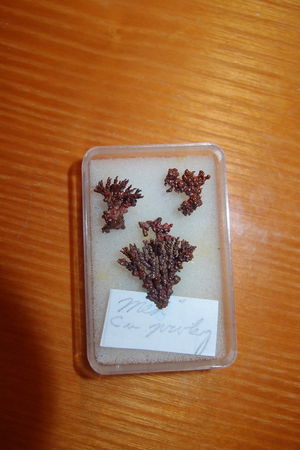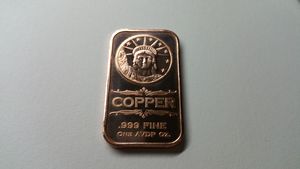Copper
Copper is a transition metal with the symbol Cu and the atomic number 29. It is a widely available commodity and can be obtained in numerous forms. It is an amphoteric metal that exists in two common oxidation states, +1 and +2, and can also exist in a +3 and a +4 state. Copper itself is chemically resistant, but its oxidation states show tendencies to react. It can be plated out of solution or replaced by a more active metal.
Contents
Properties
Physical properties
Copper is a reddish metal that is highly malleable and ductile. It can take a high polish, but often appears dull. Older pieces may be coated with the black copper(II) oxide. It has extremely high conductance of both heat and electricity.
Chemical properties
Copper is notable for its varied chemistry. Copper metal will not dissolve in strong acids, but the addition of an oxidizer such as hydrogen peroxide permits the dissolution of the metal in most acids. NWhen a sufficiently strong reducer, such as iodide or ascorbic acid, is used to oxidize copper, it may enter the +1 (cuprous) state. Copper(I) compounds are generally insoluble in water and highly reducing. Most of them are white, though copper(I) chloride may vary in color due to various impurities, and copper(I) oxide is red, or yellow when prepared by certain routes.
Copper also has extensive coordination chemistry in both the +1 and +2 states. While copper(I) compounds are insoluble in water, the proper ligand, such as ammonia, cyanide, thiosulfate, or chloride, the copper(I) ion becomes soluble in water. Copper(II) compounds undergo dramatic color changes with the addition of proper ligands: with chloride, a green complex forms (though a red complex, trichlorocuprate, is known to exist); with ammonia and ethylenediamine, a dark blue complex forms, with bromide, a maroon complex forms, and with ascorbic acid, a yellow complex forms.
Copper(III) compounds can be made in the amateur chemist's lab with sodium persulfate and potassium periodate.
One copper(IV) compound is known to exist, but is inaccessible to the amateur due to the requirement of fluorine gas.
Availability
Copper is a common coinage material, and can be found in United States pennies made before 1983. These are an alloy of 95% copper and 5% tin.
Several types of wiring contain copper metal. These wires may be glazed and will require removal before use.
Many electronics contain copper, such as transistors (the back metal plate that is in contact with the heat sink or covered by the plastic case), diodes (the wire), pins (though most are brass), rectifiers, PCBs, computer chips, on rare occasions some heat sinks are made of copper (or brass) etc. Some transistor heat sinks sometimes have an extra copper plate, for better heat dispersion.
Preparation
Copper metal powder can be made from copper(II) sulfate, available as root killer for septic systems, with the addition of either zinc metal or aluminium metal and a chloride source (such as table salt).
Copper powder can be made by reducing a copper salt, such as copper sulfate with iron. If impure iron, such as steel is used, the carbon from the steel will contaminate the solution and may slightly passivate the metal. However the black powder also contains copper(II) oxide, which too is black. The copper powder will require washing, though a simple decantation will suffice, as copper is denser than both contaminants.
Under certain circumstances, a copper foil may be produced instead of powder, usually if copper(II) chloride is used, in an acidic solution.
Clean, superfine, and air-stable copper powder can be created by adding ascorbic acid(vitamin C) to a solution of copper sulfate followed by boiling for a time. An excess of ascorbic acid yields the copper powder and a yellow solution; the composition of this solution has yet to be determined.[1]
Projects
- Illustrations of Le Chatelier's principle
- Growing crystals
- Copper soap
- Copper alloys
Handling
Safety
Copper metal poses little toxicity and clean copper metals are known to have antiseptic properties, thought not as powerful as silver.
Copper compounds are moderately toxic. They are irritant on contact with the eyes, mucous or inhaled.
Storage
Copper metal will develop a thin layer of oxide on its surface, that is usually not a problem and can be easily removed. However, if the copper metal was cleaned with acid before and hasn't been thoroughly washed, there is a risk of forming a patina. Copper powder is more sensitive and in moist air will rapidly oxidize to CuO. It is best stored in closed containers, either in inert gas (CO2 is enough) or under water or any other solvent. In case of the latter, there is the problem when drying the powder, as it may oxidize if done at a temperature too high in open air.
Hygroscopic copper compounds should be stored in sealed containers, to prevent them from absorbing the water from air.
Disposal
Special disposal procedures are required with copper compounds. All copper waste should be converted to the +2 state with peroxide and converted to the carbonate. This waste should never be dumped down the drain: rather it should be taken to the proper disposal facility or recycled.
Recycling copper back to metallic form is easy: dissolve the copper(II) carbonate in a suitable acid, such as sulfuric acid, and then add in a reducing agent. Iron, zinc or aluminium are a good choice as they're cheap and available in large quantities. If aluminum is used, a chloride source should be added to promote replacement and break the protective Al2O3 layer.
See also
References
- ↑ Experiment performed 6/17/14 by No Tears Only Dreams Now


